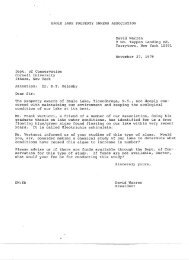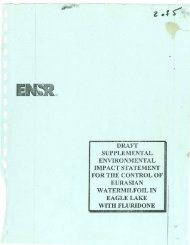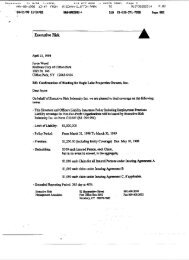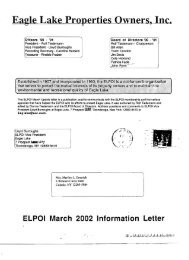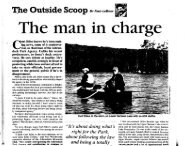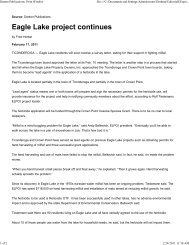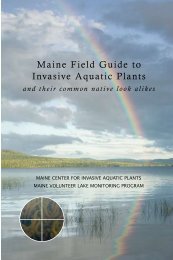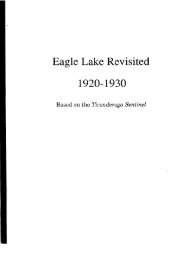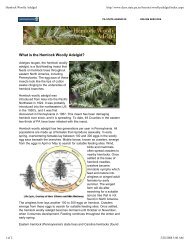Adirondack Park - Eagle Lake Property Owner's Inc.
Adirondack Park - Eagle Lake Property Owner's Inc.
Adirondack Park - Eagle Lake Property Owner's Inc.
Create successful ePaper yourself
Turn your PDF publications into a flip-book with our unique Google optimized e-Paper software.
egimes. Recent research suggests that this plant preserves some ecological function in invaded<br />
sites. However, dense Phragmites stands in North America can crowd out native species, thereby<br />
decreasing native biodiversity and quality of wetland habitat, particularly for migrating waders<br />
and waterfowl species. As with many invaders it’s appearance at a given local is often linked to<br />
disturbances (i.e. roadside ditch maintenance, road salting).<br />
Adapted from:<br />
http://www.invasiveplants.net/phragmites/Default.asp<br />
Alewife (Alosa pseudoharengus)<br />
Now in LC and Green Pond, Santa Clara, Franklin County in Saranac drainage. A total of seven<br />
individuals were found in L. Champlain in 2003 and 2004. Source of population is unclear,<br />
perhaps linked to a population established <strong>Lake</strong> St. Catherine in Poultney, Vermont, in the late<br />
1990’s. It’s appearance in <strong>Lake</strong> Champlain may also be linked to the Richelieu river or some<br />
source other than <strong>Lake</strong> St. Catherine. In other waters (notably the Great <strong>Lake</strong>s), alewife have<br />
been linked to reproduction problems in the trout and salmon that feed upon them. This<br />
thyaminase-driven Early Mortality Syndrome has generated great concern within the <strong>Lake</strong><br />
Champlain Fisheries Technical Committee, tasked with managing/establishing sustainable<br />
populations of lake trout and Atlantic land-locked salmon.<br />
Sea lamprey (Petromyzon marinus)<br />
Though recent genetic analysis indicates sea lamprey is a native species, it remains classified as a<br />
nuisance species with an enormous impact on lake trout, landlocked salmon, and other native<br />
fish in <strong>Lake</strong> Champlain. Its parasitic life style at the sub-adult stage results in extremely high<br />
wounding rates for its targeted species – primarily salmon and trout. The economic damage<br />
attributable to this species has not been calculated to date, though some costs have been tallied.<br />
Sea lamprey control is prominently listed in the <strong>Lake</strong> Champlain Basin Program ANS Plan, and<br />
is only mentioned for completeness in the <strong>Adirondack</strong> ANS Plan.<br />
Native but widely introduced fish species (NWBI): not counted in priority species of concern.<br />
See table III.1 and related discussion.<br />
Zebra mussel (Dreissena polymorpha)<br />
(revise below text from LCBP ANS Plan)<br />
The zebra mussel, a small freshwater mollusk native to Eastern Europe, likely entered <strong>Lake</strong><br />
Champlain through the Champlain Barge Canal. It was first discovered in the southern end of the<br />
<strong>Lake</strong> in 1993 and can now be found throughout the entire length of the <strong>Lake</strong>. In 1997, zebra<br />
mussel larvae, known as veligers, were recorded at a level in excess of 400,000 veligers/m 3 in the<br />
southern end of the <strong>Lake</strong>. In many areas, all firm submerged surfaces are densely covered by<br />
adult zebra mussels.<br />
In 1995, zebra mussels were found in the New York portion of the <strong>Lake</strong> Champlain Basin in<br />
Glen <strong>Lake</strong> in Queensbury, a few miles south of <strong>Lake</strong> George. In 1995 and 1997, zebra mussel<br />
veligers were found in <strong>Lake</strong> George, and adults were subsequently found in the southern part of<br />
the <strong>Lake</strong>. While active control and spread prevention programs are currently in place in <strong>Lake</strong><br />
George, a new population of adult zebra mussels was discovered in 2004. The New York<br />
infestations were likely caused by the overland transport of contaminated boats. The upper<br />
24



